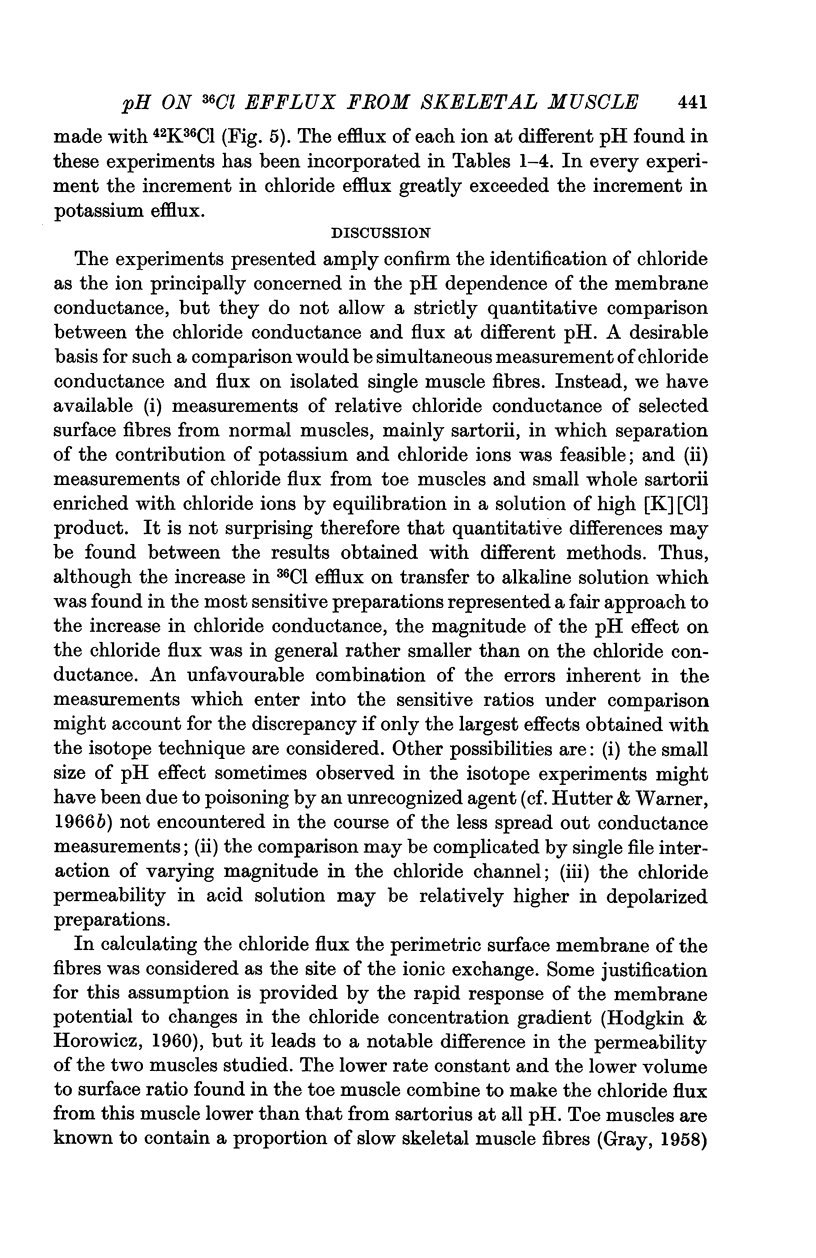Abstract
1. Frog sartorii and toe muscles were loaded in a 100 mM-K 216 mM-Cl solution at pH 7·4 labelled with either 36Cl, or 42K, or with both isotopes. The efflux of the isotopes into inactive solution of the same composition at pH 5·0 and 9·8 was followed.
2. The efflux of 36Cl into acid solution was extremely slow so that the cellular fraction could easily be distinguished. On raising the pH the efflux of 36Cl from sartorii increased 4·5 ± 0·43 (mean ± S.E.) times; from toe muscles 6·7 ± 0·69 (mean ± S.E.) times. The effect was fully reversible.
3. The efflux of 42K from sartorii was only slightly increased by alkaline solutions. When the effluxes of 36Cl and 42K were measured simultaneously the increment in chloride efflux was much greater than the increment in 42K efflux.
4. Toe muscles depolarized by high potassium solution showed an approximately twofold increase in 42K efflux on transfer from acid to alkaline solution. This effect was independent of the presence of chloride ions.
5. The results confirm the identification of chloride as the ion species principally concerned in the pH sensitivity of the membrane conductance.
Full text
PDF
















Selected References
These references are in PubMed. This may not be the complete list of references from this article.
- ADRIAN R. H. Internal chloride concentration and chloride efflux of frog muscle. J Physiol. 1961 May;156:623–632. doi: 10.1113/jphysiol.1961.sp006698. [DOI] [PMC free article] [PubMed] [Google Scholar]
- ADRIAN R. H. Potassium chloride movement and the membrane potential of frog muscle. J Physiol. 1960 Apr;151:154–185. [PMC free article] [PubMed] [Google Scholar]
- Adrian R. H., Freygang W. H. The potassium and chloride conductance of frog muscle membrane. J Physiol. 1962 Aug;163(1):61–103. doi: 10.1113/jphysiol.1962.sp006959. [DOI] [PMC free article] [PubMed] [Google Scholar]
- BURKE W., GINSBORG B. L. The electrical properties of the slow muscle fibre membrane. J Physiol. 1956 Jun 28;132(3):586–598. doi: 10.1113/jphysiol.1956.sp005551. [DOI] [PMC free article] [PubMed] [Google Scholar]
- FRANK G. B. Effects of changes in extracellular calcium concentration on the potassium-induced contracture of frog's skeletal muscle. J Physiol. 1960 Jun;151:518–538. doi: 10.1113/jphysiol.1960.sp006457. [DOI] [PMC free article] [PubMed] [Google Scholar]
- GRAY E. G. The structures of fast and slow muscle fibres in the frog. J Anat. 1958 Oct;92(4):559–562. [PMC free article] [PubMed] [Google Scholar]
- HODGKIN A. L., HOROWICZ P. Movements of Na and K in single muscle fibres. J Physiol. 1959 Mar 3;145(2):405–432. doi: 10.1113/jphysiol.1959.sp006150. [DOI] [PMC free article] [PubMed] [Google Scholar]
- HODGKIN A. L., HOROWICZ P. The effect of sudden changes in ionic concentrations on the membrane potential of single muscle fibres. J Physiol. 1960 Sep;153:370–385. doi: 10.1113/jphysiol.1960.sp006540. [DOI] [PMC free article] [PubMed] [Google Scholar]
- HODGKIN A. L., KEYNES R. D. The potassium permeability of a giant nerve fibre. J Physiol. 1955 Apr 28;128(1):61–88. doi: 10.1113/jphysiol.1955.sp005291. [DOI] [PMC free article] [PubMed] [Google Scholar]
- HUBBARD S. J. The electrical constants and the component conductances of frog skeletal muscle after denervation. J Physiol. 1963 Mar;165:443–456. doi: 10.1113/jphysiol.1963.sp007069. [DOI] [PMC free article] [PubMed] [Google Scholar]
- Hutter O. F., Warner A. E. The pH sensitivity of the chloride conductance of frog skeletal muscle. J Physiol. 1967 Apr;189(3):403–425. doi: 10.1113/jphysiol.1967.sp008176. [DOI] [PMC free article] [PubMed] [Google Scholar]
- KEYNES R. D. The ionic fluxes in frog muscle. Proc R Soc Lond B Biol Sci. 1954 May 27;142(908):359–382. doi: 10.1098/rspb.1954.0030. [DOI] [PubMed] [Google Scholar]
- KIMIZUKA H., KOKETSU K. CHANGES IN THE MEMBRANE PERMEABILITY OF FROG'S SARTORIUS MUSCLE FIBERS IN CA-FREE EDTA SOLUTION. J Gen Physiol. 1963 Nov;47:379–392. doi: 10.1085/jgp.47.2.379. [DOI] [PMC free article] [PubMed] [Google Scholar]
- Popják G. Appendix 2. Preparation of solid samples for assay of C. Biochem J. 1950 May;46(5):560–561. doi: 10.1042/bj0460560. [DOI] [PMC free article] [PubMed] [Google Scholar]


